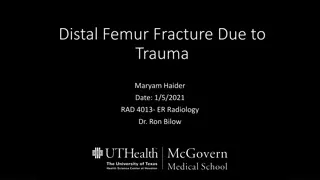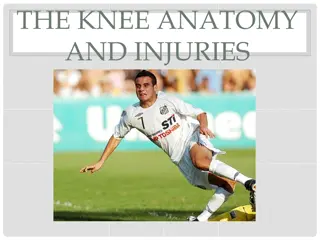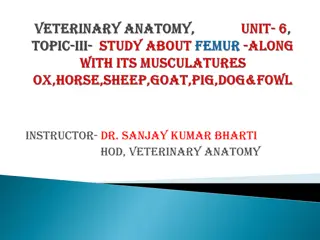Best Knee Replacement Surgeons in India
Knee is the largest joint of the human body, it is a hinge joint which allows flexion and extension and also slight internal and external rotation. It connects our thigh to our lower leg. Similar to all other joints, the knees are part of our skeletal system. The knee helps to support our weight. It
0 views • 2 slides
Exploring the Human Skeletal System
The skeletal system is crucial for protecting organs, providing structure for movement, storing minerals, and producing blood cells. It consists of the axial and appendicular skeleton, with bones classified into long, short, flat, and irregular shapes. Long bones, such as the femur, play a key role
2 views • 28 slides
Understanding Insect Legs: Anatomy and Adaptations
Explore the intricate anatomy of insect legs, comprising segments like coxa, trochanter, femur, tibia, and tarsus, each serving specific functions for locomotion. Discover how these legs are adapted for diverse tasks like walking and running in different insect species.
0 views • 18 slides
X-ray Image-Based Navigation for Hip Osteotomy Experiment
Experiment conducted using a cadaver specimen to assess the feasibility of BB implantation and visibility on X-ray images. The team cleared tissue, drilled burrs in the femur, attached BBs, and evaluated visibility and sizing on C-arm images. Results showed successful BB fixation. Predicted method f
0 views • 8 slides
Sex Determination Through Bone Analysis in Forensic Anthropology
In forensic anthropology, the pelvis and skull are crucial in sex determination, with additional assistance from femur, tibia, and humerus measurements. This data sheet guides on circling male or female based on traits like sub-pubic angle, pelvic cavity shape, eye orbit sharpness, zygomatic process
0 views • 33 slides
Lower Limb Trauma: Injuries and Management Overview
This collection of images and descriptions covers common lower limb injuries, such as neck of femur, femoral fractures, and knee injuries. It provides insights into the assessment, treatment, and potential complications associated with lower limb trauma, emphasizing the importance of prompt evaluati
0 views • 38 slides
Understanding Perthes Disease in Pediatric Patients
Perthes disease, also known as Legg-Calve-Perthes disease, is a common pediatric disorder affecting the blood supply to the rounded head of the femur. It typically affects male children aged 3-10 years old and presents with symptoms such as limping, pain, and stiffness in the hip area. The disease p
0 views • 13 slides
Pediatric Ankle and Knee Pain Imaging Findings
Images show calcifications in Achilles tendon and deep to plantar fascia in a 7-year-old with ankle pain, as well as a cortical abnormality in the distal femur of a 16-year-old girl presenting with knee pain. The significance of these findings requires further evaluation by a medical professional.
0 views • 6 slides
Distal Femur Fracture Diagnosis and Management Overview
Maryam Haider, a 45-year-old male, presented with a severe distal femur fracture following a traumatic incident. This case includes initial history and physical examination findings, differential diagnosis considerations, relevant imaging studies depicting the extent of the injuries, and key finding
0 views • 19 slides
Anatomy of Lower Limb Bones: Thigh (Femur and Patella) Overview
Explore the detailed anatomy of the bones in the lower limb, specifically focusing on the thigh bones - the femur and patella. Learn about the structure, function, and key features of these bones, including their articulations, surfaces, and attachments. Enhance your understanding of the classificat
0 views • 22 slides
Understanding Knee Anatomy and Injuries
Explore the intricate structures of the knee joint, including the femur, patella, meniscus, ligaments, and muscles. Learn about common knee injuries and their impact on stability and function. Delve into the complexities of the ACL, PCL, MCL, and LCL ligaments, crucial for knee integrity during vari
0 views • 40 slides
Understanding the Anatomy of the Femur in Veterinary Science
The femur, being the most massive and longest bone in the body, plays a crucial role in the skeletal system. It articulates with various structures to form joints such as the hip joint and stifle joints. The shaft of the femur is composed of distinct surfaces and features, each serving specific func
0 views • 14 slides
Lower Limb Bones Anatomy Overview
Explore the bones of the lower limb, including the femur and patella of the thigh. Learn about the structure and features of these bones such as the head, neck, trochanters, and shaft of the femur. Enhance your knowledge on the classification of bones in the thigh, leg, and foot regions, distinguish
0 views • 22 slides












